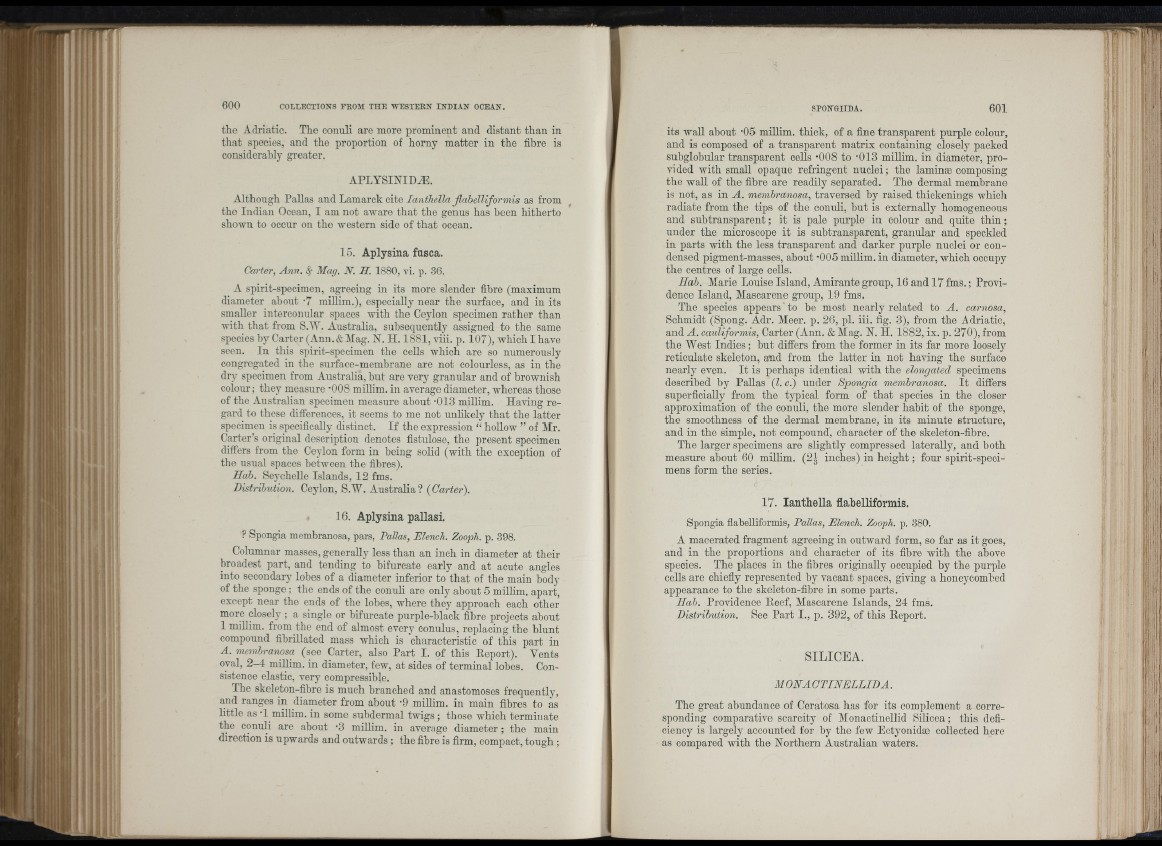
j l i ï
i i
i M
the Adriatic. The conuli are more prominent and distant than in
th at species, and the proportion of horny matter in the fibre is
considerably greater.
APLYSINIDÆ.
Although. Pallas and Lamarck cite lanthella ßahelliformis as from
tho Indian Ocean, I am not aware th a t the genus has been hitherto
shown to occur on the western side of th a t ocean.
15. Aplysina fusca.
Carter, Ann. Sf Mag. N. H. 1880, vi. p. 36.
A spirit-specimen, agreeing in its more slender fibre (maximum
diameter about -7 millim.), especially near the surface, and in its
smaller interconnlar spaces with the Ceylon specimen rather than
with th at from S.W. Australia, subsequently assigned to the same
species by Carter (Ann. & Alag. N. H. 1881, viii. p. 107), which I bave
seen. In this spirit-specimen the cells which are so numerously
congregated in the surface-membrane are not colourless, as in the
dry specimen from Australia, but are very granular and of brownish
colour; they measure -008 millim. in average diameter, wbereas those
of the Australian specimen measure about '013 millim. Having regard
to these differences, it seems to me not unlikely th at the latter
specimen is specifically distinct. I f the expression “ hollow ” of Air.
Carter’s original description denotes fistulöse, the present specimen
differs from the Ceylon form in being solid (with tbe exception of
the usual spaces between tbe fibres).
Hab. Seychelle Islands, 12 fms.
Distribution. Ceylon, S.W. Australia? (Garter).
16. Aplysina pallasi.
? Spongia membranosa, pars, Pattas, Elench. Zooph. p. 398.
Columnar masses, generaUy less than an inch in diameter at their
broadest part, and tending to bifurcate early and at acute angles
into secondary lobes of a diameter inferior to th at of the main body
of the sponge ; the ends of the conuli are only about 5 millim. apart,
except near the ends of the lobes, where they approach each other
more closely ; a single or bifurcate purple-black fibre projects about
1 miUim. from the end of almost every conulus, replacing the blunt
compound fibrillated mass wbicb is characteristic of tbis part in
A. membranosa (see Carter, also P a rt I. of this Peport). Vents
oval, 2 -4 miUim. in diameter, few, at sides of terminal lobes. Consistence
elastic, very compressible.
Tbe skeleton-fibre is mucb branched and anastomoses frequently,
and ranges in diameter from about -9 miUim. in main fibres to as
little as -1 millim. in some suhdermal twigs ; those which terminate
the conuli are about '3 millim. in average diameter ; the main
direction is upwards and outwards ; tbe fibre is firm, compact, tough ;
its wall about ‘05 millim. thick, of a fine transparent purple colour,
and is composed of a transparent matrix containing closely packed
subglobular transparent ceUs -008 to -013 millim. in diameter, provided
witb small opaque réfringent nuclei; tbe laminæ composing
tbe wall of the fibre are readily separated. The dermal membrane
is not, as in A. membranosa, traversed by raised thickenings which
radiate from the tips of tbe connli, but is externally homogeneous
and subtransparent ; it is pale purple in colour and quite thin ;
under tbe microscope it is suhtransparent, granular and speckled
in parts witb tbe less transparent and darker purple nuclei or condensed
pigment-masses, about -005 millim. in diameter, wbicb occapy
the centres of large cells.
Hab. Marie Louise Island, Amirante group, 16 and 17 fms. ; Providence
Island, Mascarene group, 19 fms.
Tbe species appears ' to be most nearly related to A . carnosa,
Schmidt (Spong. Adr. Meer. p. 26, pi. iii. fig. 3), from tbe Adriatic,
and A. cauliformis, Carter (Ann. & Alag. N. H. 1882, ix. p. 270), from
tbe West Indies ; but differs from tbe former in its far more loosely
reticulate skeleton, and from tbe latter in not having tbe surface
nearly even. I t is perhaps identical with the elongated specimens
described by Pallas (I. c.) under Spongia membranosa. I t differs
superficially from tbe typical form of th at species in the closer
approximation of the conuli, tbe more slender habit of the sponge,
the smoothness of the dermal membrane, in its minute structure,
and in the simple, not compound, character of tbe skeleton-fibre.
The larger specimens are slightly compressed laterally, and botb
measure about 60 millim. (2 / inches) in height ; four spirit-specimens
form tbe series.
17. lantbella flabelliformis.
Spongia flabelliformis, Pallas, Elench. Zooph. p. 380.
A macerated fragment agreeing in outward form, so far as it goes,
and in tbe proportions and character of its fibre with the above
species. The places in tbe fibres originally occupied by tbe purple
cells are chiefly represented by vacant spaces, giving a honeycombed
appearance to the skeleton-fibre in some parts.
Hah. Providence Peef, Alascarene Islands, 24 fms.
Distribution. See Part I., p. 392, of this Peport.
S IL IC E A .
MONA C T IN E L L ID A .
The great abundance of Ceratosa has for its complement a corresponding
comparative scarcity of Monactinellid Silicea ; this deficiency
is largely accounted for by the few Ectyonidæ collected here
as compared witb tbe Northern Australian waters.
i l
i l è i
“ i A'
I . 1/
|,i
i I i' ■